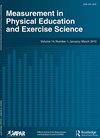Measurements of Lower-limb Isometric Single-joint Maximal Voluntary Torque and Rate of Torque Development Capacity Offer Limited Insight into Vertical Jumping Performance
IF 1.9
4区 教育学
Q2 EDUCATION & EDUCATIONAL RESEARCH
Measurement in Physical Education and Exercise Science
Pub Date : 2021-06-08
DOI:10.1080/1091367X.2021.1937176
引用次数: 2
Abstract
ABSTRACT We examined the relationships between heights of different vertical jumps and isometric single-joint strength characteristics of ankle, knee, hip, and trunk joints in young male soccer players (n = 117). The highest peak torque and rate of torque development (RTD) outcomes were in low to moderate correlation with jump heights (r = 0.25–0.50). The correlations were generally higher for bilateral than unilateral jumps. Linear regression models accounted for 33–35% and 24.5 of the variance in bilateral and unilateral jump height, respectively. Hip extension peak torque, ankle RTD and trunk lateral flexion peak torque were most consistently included in the regression models. Our results suggest the that single-joint isometric testing does not seem to be useful to detect weaknesses related to vertical jump performance. The relative importance of individual lower limb joints for vertical jumping seems comparable. Trunk strength should not be neglected as the determinant of jumping performance.下肢等距单关节最大自主扭矩和扭矩发展能力的测量为垂直跳跃性能提供了有限的见解
摘要:我们研究了117名年轻男性足球运动员不同垂直跳跃高度与踝关节、膝关节、髋关节和躯干关节等尺度单关节强度特征之间的关系。最高峰值扭矩和扭矩发展率(RTD)结果与跳跃高度呈低至中度相关(r = 0.25-0.50)。双边跳跃的相关性通常高于单边跳跃。线性回归模型分别占双侧和单侧跳高方差的33-35%和24.5。髋部伸展峰值扭矩、踝关节RTD和躯干侧屈峰值扭矩最一致地包含在回归模型中。我们的研究结果表明,单关节等长测试似乎对检测与垂直跳跃性能相关的弱点并不有用。个体下肢关节对于垂直跳跃的相对重要性似乎是可以比较的。躯干强度作为跳跃性能的决定因素不应被忽视。
本文章由计算机程序翻译,如有差异,请以英文原文为准。
求助全文
约1分钟内获得全文
求助全文
来源期刊

Measurement in Physical Education and Exercise Science
Medicine-Orthopedics and Sports Medicine
CiteScore
4.20
自引率
33.30%
发文量
24
期刊介绍:
The scope of Measurement in Physical Education and Exercise Science (MPEES) covers original measurement research, special issues, and tutorials within six substantive disciplines of physical education and exercise science. Six of the seven sections of MPEES define the substantive disciplines within the purview of the original research to be published in the journal: Exercise Science, Physical Activity, Physical Education Pedagogy, Psychology, Research Methodology and Statistics, and Sport Management and Administration. The seventh section of MPEES, Tutorial and Teacher’s Toolbox, serves to provide an outlet for review and/or didactic manuscripts to be published in the journal. Special issues provide an avenue for a coherent set of manuscripts (e.g., four to five) to collectively focus in-depth on an important and timely measurement-related issue within the scope of MPEES. The primary aim of MPEES is to publish high-impact manuscripts, most of which will focus on original research, that fit within the scope of the journal.
 求助内容:
求助内容: 应助结果提醒方式:
应助结果提醒方式:


